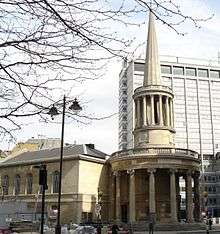Langham Place, London

Langham Place is a short street in Westminster, central London, England.[1] It connects Portland Place to the north with Regent Street to the south in London's West End.
Buildings
There are several major buildings on Langham Place, including All Souls Church, Broadcasting House, and the Langham Hotel. Queen's Hall was also here until its destruction in 1941 during World War II. The area is associated with the architect John Nash, although all but one of his original buildings have since been replaced.[2] Starting from the north, these are:
Broadcasting House

Broadcasting House is the BBC's headquarters. It was built in the 1930s in the Art Deco style, designed by the architect George Val Myer. Several of the BBC's national radio stations broadcast from the building. The New Broadcasting House extension, home of the BBC News Centre, was built in 2005, and first used for broadcasting in 2013.
Langham Hotel

The Langham Hotel, on the west side of Langham Place, was built between 1863 and 1865 at a cost of £300,000. It is one of the largest and best known traditional hotels in London.
All Souls Church
All Souls Church, just south of Broadcasting House, has a distinctive circular portico topped with a stone spire. Completed in 1823 and consecrated in 1824, All Souls is the only surviving building in the area that was designed by John Nash.
Queen's Hall

Queen's Hall was a classical music concert hall. It opened in 1893 but was destroyed by an incendiary bomb during the Blitz in 1941. It is best known for being where the Promenade Concerts ("Proms") were founded by Robert Newman, with Sir Henry J. Wood, in 1895.[3]
Organisations
The Langham Place Group
19 Langham Place was for a decade from the late 1850s the office of the English Woman's Journal. Its premises included a reading room, a coffee shop, and meeting space for the initiatives which gathered around it, mainly to do with education and work (e.g. the Society for Promoting the Employment of Women [4]). It served as a sort of counterpart to the gentlemen's clubs then so important in London. The magazine was largely funded by Helena, comtesse de Noailles[5] and the hire of the building by Theodosia Monson.[6] The so-called Langham Place group was the circle of like-minded women who gathered there, including Helen Blackburn, Jessie Boucherett and Emily Faithfull.[7]
References
- ↑ Langham Place Guide, LondonTown.com.
- ↑ Regent Street History and Construction.
- ↑ Ivan Hewett (12 July 2007). "The Proms and the Promenerders". Daily Telegraph. Retrieved 2008-07-20.
- ↑ Gerry Holloway (2005). Women And Work In Britain Since 1840. London: Routledge. p. 216. ISBN 0415259118.
- ↑ http://www.oxforddnb.com/view/theme/93708?back=,59337
- ↑ http://www.oxforddnb.com/view/article/59337
- ↑ Hunt, Felicity. Oxford Dictionary of National Biography (online ed.). Oxford University Press. doi:10.1093/ref:odnb/37409. (Subscription or UK public library membership required.)
Coordinates: 51°31′04″N 0°08′36″W / 51.5179°N 0.1434°W
